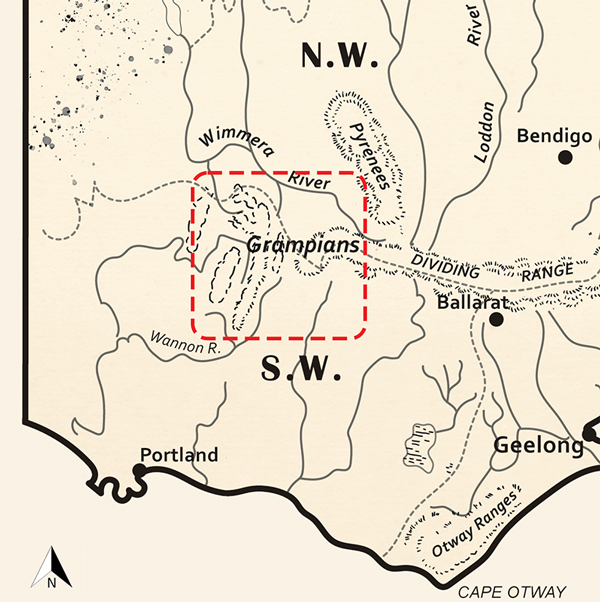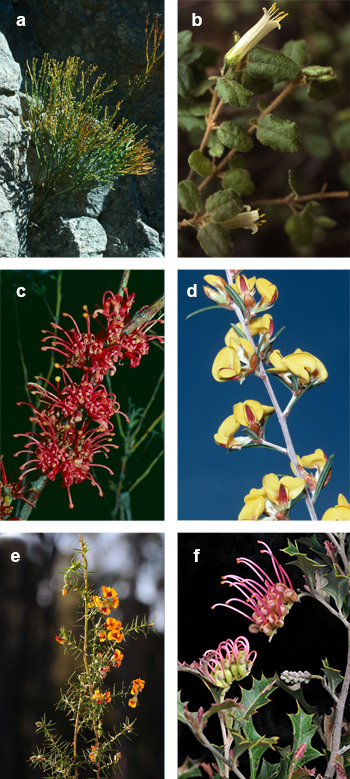The Grampians
For over 40 years Herbert Bennett Williamson visited the Greater Grampians region on no less than 25 occasions1 almost exclusively during holiday leave from his teaching duties. Williamson’s journeys throughout this region were conducted predominantly on foot and bicycle, over hundreds of kilometres of scarcely signed landscape. It was not until the later 1920s that he would adopt the ‘luxury’ of a motorcar.
Until early in the twentieth century, much of the far Western district was botanically relatively unexplored terrain by white Australians.


The Field Naturalists' Club of Victoria
The majority of Williamson’s journeys were taken alone, however on occasion he was accompanied by members of the Field Naturalists’ Club of Victoria (FNCV). One particularly successful expedition was undertaken in October 1927. Members Mr. E.E. Pescott, F.L.S. (FNCV president), Mr. C. Daley, B.A., F.L.S., Mr. C.L. Barrett, C.M.Z.S. (editor of The Victorian Naturalist) and Mr. V.H. Miller were present for the ten-day tour, taking in the Southern and Northern ends of the Grampians, with a detour at Mount Arapiles.
During this trip, Williamson collected several rare and interesting specimens, with some of his finds reported in newspapers across Australia. Pescott remarked that Williamson’s extensive knowledge of Victorian flora and the Grampians terrain was invaluable to the Club’s collecting endeavours2.

Discoveries at the Grampians
Pultenaea patellifolia H.B. Will.
This specimen — new to science at the time of its discovery — was discovered and collected by Williamson at Mt. Byron in the Black Ranges (part of the Grampians), in October 1927. The story of the discovery and collection of this species was told in The Herald newspaper in 1927.
This species was formally described by Williamson in a publication in the Proceedings of the Royal Society of Victoria in 1928. Pultenaea patellifolia, known by the common name Mt. Byron Bush-pea, is considered rare; it only grows in open-forest in the Black Ranges3.
I have the honour to send you with this a packet containing specimen of a Grevillea, which I discovered in the Victorian Grampians in Oct 1893 and which the late Baron von Mueller described in The Victorian Naturalist for Dec 1899, naming it in my honour.
- Letter written by H.B. Williamson accompanying specimen sent to the Herbarium at The Royal Botanic Gardens, Kew (K), dated 5 Oct 1899 (below).
Letter written by H.B. Williamson accompanying specimen sent to the Herbarium at the Royal Botanic Gardens, Kew (K) dated 5 Oct 1899 [K000799702 & K000799703]. Specimen image courtesy of Royal Botanic Gardens, Kew. © copyright of the Board of Trustees of the Royal Botanic Gardens, Kew.
Sending specimens worldwide
Williamson’s passion for surveying Victorian flora and sharing his finds with others included internationally renowned botanists and institutions. In addition to his considerable contributions to Australian herbaria, Williamson sent specimens found in the Grampians to Kew herbarium in London, as well as the Museum of Natural History in Washington D.C.
In total, Williamson formally described 60 plant species4 and for each of those species a type specimen (such as the one shown to the left), which represents the features and dimensions of that species is provided to a national or international herbarium for reference by other researchers.
Collection of the type specimen to describe the plant features often requires multiple visits, as Williamson notes in the letter accompanying this specimen, ‘wishing to obtain fruit (in vain) I watched it for 6 seasons refraining from plucking many specimens.’

Flora of the Grampians
[a] Psilotum nudum (L.) P.Beauv.
Skeleton Forkfern
In Victoria considered vulnerable. Known to occur at Mt Arapiles and in the northern Grampians in the west and an isolated occurrence north of East Gippsland in the north east of the state (VicFlora, 2021).
© Jeff Jeans, RBGB 2021, CC BY-NC-SA 4.0.
[b] Correa aemula F.Muell.
Hairy Correa
Rare correa
© Geoff Lay, RBGB 2021, CC BY-NC-SA 4.0.
[c] Grevillea dimorpha F. Muell.
Flame Grevillea
Rare species endemic to the Grampians
© Gwen & Rodger Elliot, RBGB, 2021, CC BY-NC-SA 4.0.
[d] Pultenaea benthamii F.Muell.
Bentham’s Bush-pea
Rare in Victoria
© Ian McCann, RBGB, 2021, CC BY-NC-SA 4.0.
[e] Pultenaea juniperina Labill.
Prickly Bush-pea
Confined to heathland in moist forest in The Grampians, with a disjunct occurrence near Tonimbuk (VicFlora, 2019).
© Ian Clarke, RBGB, 2021, CC BY-NC-SA 4.0.
[f] Grevillea aquifolium Lindl.
Holly grevillea
© Ian Clarke, RBGB, 2021, CC BY-NC-SA 4.0.
References
1. Australasian Virtual Herbarium, [Internet]. Council of Heads of Australasian Herbaria. 2021. H.B. Williamson’s Victorian specimens [cited 2021 Mar 4]. Available from AVH website
2. Pescott EE. Excursion through the Western District of Victoria. The Victorian Naturalist. 1927;45:5–13.
3. VicFlora Royal Botanic Gardens Victoria. Pultenaea patellifolia H.B.Will [Internet]. South Yarra (Victoria): Flora of Victoria, Royal Botanic Gardens Victoria; 2016 [updated 2019 Sept 18; cited 2021 Apr 8]. Available from: https://vicflora.rbg.vic.gov.au/flora/taxon/4195288d-03c4-48a9-9da5-493d23266e54
4. Australian Plant Name Index, [Internet]. Centre for Australian National Biodiversity Research, Australian Government, Canberra. 2021. H.B.Will. [cited 2021 May 23].
5. Plants of the World Online [Internet]. Board of Trustees of the Royal Botanic Gardens Kew. 2021. Grevillea williamsonii F.Muell. [cited 2020 Nov 28].
